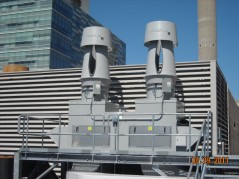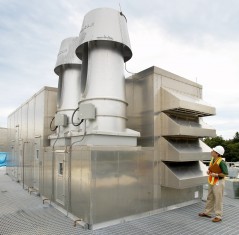Q. The commissioning engineer has commented that the Heat Recovery Unit (HRU) does not meet the 25’ separation distance between the Intake hood and Exhaust Discharge requirement.
I believe that our design with the effective plume height of 44’ and the fan discharge 16’ above the inlet of the intake hood is better than a fan 25’ away from an intake. We know that plumes do not come straight down. Do you have any comment regarding separation of air intakes from exhaust discharge or have you seen this type of issue before and provided helpful information?
 A. We recognize the recommendation in ASHRAE Standard 170-2008 (the Ventilation of Healthcare Facilities) which calls for recommended distance offsets between exhaust stacks and air intakes (placing an exhaust discharge 25′ from an intake). This recommendation serves as a very useful guide to engineers. It’s language is seen in other standards and shared by local standards as well.
A. We recognize the recommendation in ASHRAE Standard 170-2008 (the Ventilation of Healthcare Facilities) which calls for recommended distance offsets between exhaust stacks and air intakes (placing an exhaust discharge 25′ from an intake). This recommendation serves as a very useful guide to engineers. It’s language is seen in other standards and shared by local standards as well.
In practice it is not practical to use this recommendation when evaluating High Plume Dilution Fans, like the Strobic Air Tri-Stack Fans. The Tri-Stack Fan uses a patented nozzle design to maintain stack velocities while minimizing horsepower. Increased stack velocities allow the fan to entrain outside air (up to 170% by volume). Process air and entrained air combine to produce a significantly higher effective stack height (the physical height of the equipment plus the plume height.). This stack height calculation is used by wind consultants and CFD dispersion models worldwide. The ASHRAE Standard 170-2008 does not take this stack height calculation into account and therefore should not be applied to a High Plume Dilution Fan type applications.
 With High Plume Dilution fans, like the Tri-Stack Fan, we have found that the safest place to position a fan is in close proximity to the building intakes. This insures that the diluted exhaust air will be driven up and away from the intakes. We recommend that the fan discharge velocity be maintained at 3,000 FPM per ANZI Z9.5.
With High Plume Dilution fans, like the Tri-Stack Fan, we have found that the safest place to position a fan is in close proximity to the building intakes. This insures that the diluted exhaust air will be driven up and away from the intakes. We recommend that the fan discharge velocity be maintained at 3,000 FPM per ANZI Z9.5.
Strobic Air has hundreds of laboratory fans that are located less than 25′ from air intakes. We have many of those here in New England. In 26 years Strobic Air has never experienced a single instance of re-entrainment on a laboratory.
Further questions about Laboratory Exhaust Fans – askRick?
Related Posts:
Ask Rick: Lab Exhaust Fans | What Standards to reference for Lab Exhaust Fan design?
High Plume Dilution Fans | What is a High Plume Dilution Fan?





Leave a Reply